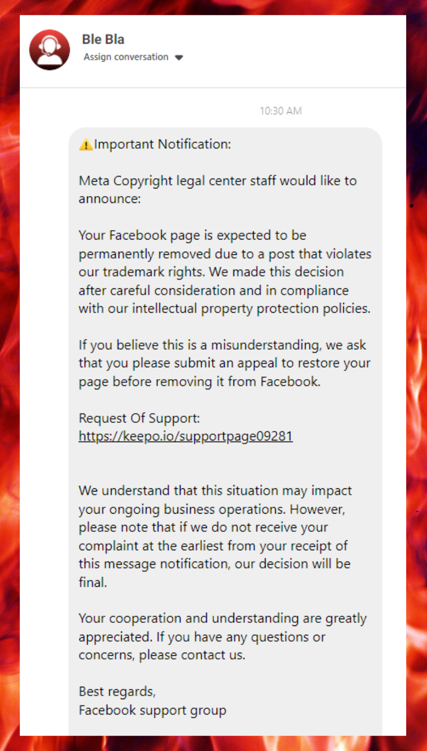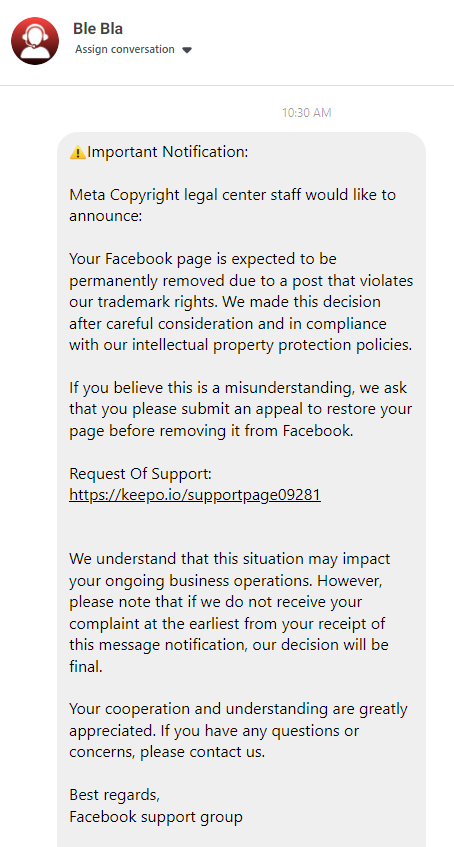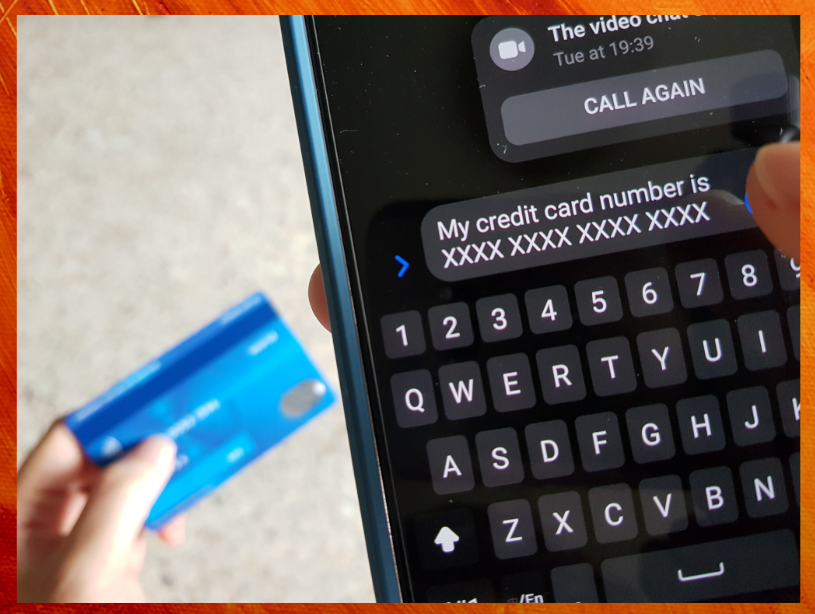Beware the Bull: Unveiling Facebook Scams Targeting Cattle Ranchers
BEWARE THE BULL: UNVEILING FACEBOOK
SCAMS TARGETING CATTLE RANCHERS


Unveiling the Mechanics: Facebook Page Hijacking Explained
Many cattle producers utilize Facebook Business pages to tell their story and help market their cattle. It’s something that I think will not be going away anytime soon and it’s something that can really add value to your sale offerings. However, operating such pages exposes you to various types of attacks.
Phishing Attacks: One common method used by scammers to hijack Facebook pages is through phishing attacks. They may send deceptive messages or emails disguised as legitimate notifications from Facebook, asking page owners to provide their login credentials or click on malicious links. Once the scammers obtain these details, they can gain unauthorized access to the page.
Compromised Passwords: Weak or reused passwords can also make Facebook pages vulnerable to hijacking. If a page owner's password is compromised through data breaches or leaked databases, attackers can use these credentials to log in and take control of the page. How often do you hear of big named companies that have been compromised with a list of users and passwords? If you are using the same password across multiple sites, this puts you at more risk.
Unauthorized Access to Admin Accounts: In some cases, scammers may gain access to an admin account associated with the page through social engineering techniques or by tricking legitimate administrators into granting them access. Once they have admin privileges, they can manipulate the page settings and content at will.
Some Examples of deceptive messages
Working with multiple cattle producers, I’ve seen my fair share of deceptive messages. Several of these are well crafted and make you think that your page is violating some terms and conditions or violating a copyright and you need to do something to correct it.
The Facebook scam typically arrives through direct messages. Pay close attention to the message, particularly the link they prompt you to click: https://keep.io/supportpage09281. Although I refrained from clicking the link, it often redirects users to a site mimicking Facebook's color scheme, but with a different URL. These deceptive sites prompt you to input your username and password, claiming it's for access. However, their true intention is to steal your credentials for malicious purposes.

Here is another Facebook scam that was found within a post comment. Employing urgent language such as "copyrighted material," "flagged," and "violation," it aimed to provoke an immediate response from the recipient. Take note of the "contact us" link provided in the message: https://linkr.bio/vlamuo-21. Such scams often leverage urgency to prompt users to click the link, but it's crucial to exercise caution and avoid falling into the trap.

How to Prevent Page Hijacking on Facebook
Use Strong Passwords: Ensure that your Facebook account password is strong, unique, and not easily guessable. Use a combination of letters, numbers, and special characters, and avoid using common phrases or personal information that could be easily obtained or guessed.
Enable Two-Factor Authentication (2FA): Activate two-factor authentication on your Facebook account to add an extra layer of security. This typically involves receiving a code on your mobile device or email that you must enter along with your password when logging in from an unrecognized device or location.
Be Wary of Phishing Attempts: Exercise caution when receiving unsolicited messages or emails claiming to be from Facebook. Verify the sender's identity and look for signs of phishing, such as misspellings, suspicious links, or requests for sensitive information. When in doubt, directly visit the Facebook website or app to check for notifications or messages.
Regularly Review Page Admins and Permissions: Regularly review the list of admins associated with your Facebook page and remove any unfamiliar or unauthorized accounts. Limit the number of admins and assign roles with appropriate permissions to minimize the risk of unauthorized access.
Monitor Page Activity: Keep a close eye on your page's activity, including posts, comments, and messages. Report any suspicious or unauthorized activity to Facebook immediately and take steps to secure your account.
Educate Page Admins: Educate all page admins about the risks of page hijacking and the importance of maintaining strong security practices. Encourage them to use unique passwords, enable 2FA, and remain vigilant against phishing attempts.
By implementing these preventive measures and staying informed about potential threats, Facebook page owners can significantly reduce the risk of their pages being hijacked by scammers.

Taking Back Control: Steps to Counter Page Hijacking
If someone hijacks your Facebook page, it's crucial to take immediate action to regain control and mitigate any potential damage. Here are the steps you should take:
Report the Issue to Facebook: Go to the Facebook Help Center and report the hijacking incident. Provide as much detail as possible about the situation, including when you noticed the unauthorized access, any suspicious activity you observed, and any relevant screenshots or evidence.
Attempt to Regain Control: If you can still access your Facebook account, attempt to regain control of the hijacked page by changing your password immediately. Go to the page settings, remove any unauthorized admins or editors, and review the page's settings for any unauthorized changes.
Use the "Trouble Accessing Your Account?" Option: If you're unable to access your account because the hijacker has changed the password or other security settings, use the "Trouble Accessing Your Account?" option on the Facebook login page. Follow the prompts to regain access, such as providing your email or phone number associated with the account or answering security questions.
Secure Your Account: Once you've regained control of your account and page, take steps to enhance its security. Enable two-factor authentication (2FA) for your Facebook account, choose a strong and unique password, and regularly monitor your account for any suspicious activity.
Inform Your Audience: If the hijacker made any unauthorized posts or changes to your page, inform your audience about the situation. Post a public announcement explaining the incident, reassuring your followers that the issue is being addressed, and advising them to ignore any suspicious content posted during the hijacking.
Monitor for Further Activity: After regaining control of your page, closely monitor it for any further unauthorized activity. Regularly check the page's settings, review its activity log, and stay vigilant for any signs of suspicious behavior or attempted hijackings.
An all-too-common oversight involves having only one administrator for your Facebook Business page. In the event of a hijack, having multiple administrators increases the likelihood of swift action. Another administrator could potentially access the page, remove the hijacker's account, and change the password, mitigating the impact of the breach.

When Deals Turn Sour: Recognizing and Avoiding Deposit Scams
Facebook scammers employ various tactics to convince victims to send money for a deposit on a bull, bred heifers, cow calf pairs, etc only to disappear without delivering. Here's how they typically execute this scam:
Fake Listings: Scammers create convincing listings or advertisements for high-quality cattle at attractive prices. They may use stolen photos and descriptions from legitimate breeders or stock images to make the offer appear legitimate.
Urgency and Limited Availability: To pressure potential victims into acting quickly, scammers often claim that the bull can be delivered immediately. They may emphasize urgency by stating that other buyers are interested or that the offer is only valid for a limited time.
Smooth Communication: Scammers use persuasive language and maintain consistent communication with victims to gain their trust. They may respond promptly to inquiries, answer questions convincingly, and provide reassurances about the legitimacy of the transaction.
Request for Deposit: Once a victim expresses interest in purchasing the bull, the scammer requests a deposit or partial payment to secure it. They may claim that the deposit is necessary to secure the bull or cover transportation costs.
Excuses and Delays: After receiving the deposit, the scammer may provide excuses for delays in delivering the bull, such as transportation issues, health concerns, or unforeseen circumstances. They may continue to string the victim along with promises of imminent delivery.
Disappearance: Once the scammer has received the deposit or payment, they vanish without delivering the bull as promised. Attempts to contact them may go unanswered, and the victim is left without recourse.
To prevent falling victim to this type of scam, individuals should:
Research Sellers: Thoroughly research the seller or breeder before making any payments. Look for reviews, check for a legitimate website or business presence, and verify their credentials with reputable sources.
Avoid Advance Payments: Be cautious about making advance payments or deposits for goods or services, especially when dealing with unknown sellers or high-value transactions. Insist on paying upon delivery or use secure payment methods that offer buyer protection.
Trust Your Instincts: If an offer seems too good to be true or if something feels off during the transaction process, trust your instincts and proceed with caution. Take the time to verify the legitimacy of the seller and the offer before making any commitments.
Report Suspicious Activity: If you encounter a suspicious listing or believe you've been targeted by a scammer, report the incident to Facebook and relevant authorities. By reporting fraudulent activity, you can help prevent others from falling victim to similar scams.
In closing
In closing, while Facebook scams continue to evolve in sophistication, awareness and vigilance remain our greatest defenses. By staying informed about common tactics, such as suspicious links and urgent messages, and by utilizing security features like two-factor authentication, we can better protect ourselves and our communities from falling victim to these deceitful schemes. Remember, if something seems too good to be true or prompts an immediate reaction, it's likely a scam. Together, through education and proactive measures, we can navigate the digital landscape with confidence and safeguard against the ever-present threat of Facebook scams.
